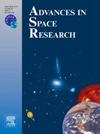Contribution analysis of the addition of laser ranging interferometry on GRACE-FO gravity field estimation under different accelerometer calibration schemes
IF 2.8
3区 地球科学
Q2 ASTRONOMY & ASTROPHYSICS
引用次数: 0
Abstract
To investigate the influence of K-Band microwave ranging (KBR) and Laser Ranging Interferometer (LRI) inter-satellite range-rates from the GRACE-FO mission on the recovery of gravity fields, this paper explores two distinct methods for accelerometer scale estimation, namely diagonal matrix parameterization and full matrix parameterization. Integrating both KBR and LRI data from GRACE-FO into gravity field recovery, we have derived six new time series of monthly gravity field solutions based on two different accelerometer calibration approaches, entitled KBRLRI_Com (incorporating both KBR and LRI data), KBR_Only (using pure KBR data), LRI_Only (solely utilizing LRI data) truncate to degree and order 60 over the period from January 2019 to June 2022. Analyses of KBRLRI_Com, KBR_Only, and LRI_Only reveal the following findings: (1) LRI demonstrates significant advantages over KBR in both diagonal and full scale matrix scenarios, across the time and frequency domains, which shows lower root mean square (RMS) values of the post-fit residuals in the time domain and substantially lower noise at higher frequencies; (2) the comparison between KBRLRI_Com, KBR_Only, and LRI_Only in terms of geoid degree error suggests that KBRLRI_Com agrees well with KBR_Only and LRI_Only at the low degrees (below degree 30), while effectively reducing the high-frequency noise, especially when the diagonal scale matrices are employed; the benefit of KBRLRI_Com solution is mainly attributed to the enhanced quantity of ranging observations. (3) by analyzing the signal and noise over the globe, ocean, Australian continent, and Amazon and Ganges river basins, we find that KBRLRI_Com is highly consistent with KBR_Only and LRI_Only in terms of spatial signals, while KBRLRI_Com exhibits less spatial noise; when employing diagonal and full matrices, the noise of gravity field solutions derived by incorporating LRI data is mitigated by 8.8 % and 3.9 % over the global ocean compared to KBR_Only, as well as 7.6 % and 3.2 % in the Australian continent; especially in the diagonal matrix case, the incorporation of LRI measurements for calculating monthly gravity fields results in a more pronounced decrease of spatial noise. (4) in the oceanic region, KBR_Only and LRI_Only have average RMS values of 11.3 cm and 11.6 cm in diagonal matrices, respectively, and 10.2 cm and 11.6 cm in the full matrix, indicating a generally comparable level of accuracy between the two models.
求助全文
约1分钟内获得全文
求助全文
来源期刊

Advances in Space Research
地学天文-地球科学综合
CiteScore
5.20
自引率
11.50%
发文量
800
审稿时长
5.8 months
期刊介绍:
The COSPAR publication Advances in Space Research (ASR) is an open journal covering all areas of space research including: space studies of the Earth''s surface, meteorology, climate, the Earth-Moon system, planets and small bodies of the solar system, upper atmospheres, ionospheres and magnetospheres of the Earth and planets including reference atmospheres, space plasmas in the solar system, astrophysics from space, materials sciences in space, fundamental physics in space, space debris, space weather, Earth observations of space phenomena, etc.
NB: Please note that manuscripts related to life sciences as related to space are no more accepted for submission to Advances in Space Research. Such manuscripts should now be submitted to the new COSPAR Journal Life Sciences in Space Research (LSSR).
All submissions are reviewed by two scientists in the field. COSPAR is an interdisciplinary scientific organization concerned with the progress of space research on an international scale. Operating under the rules of ICSU, COSPAR ignores political considerations and considers all questions solely from the scientific viewpoint.
 求助内容:
求助内容: 应助结果提醒方式:
应助结果提醒方式:


